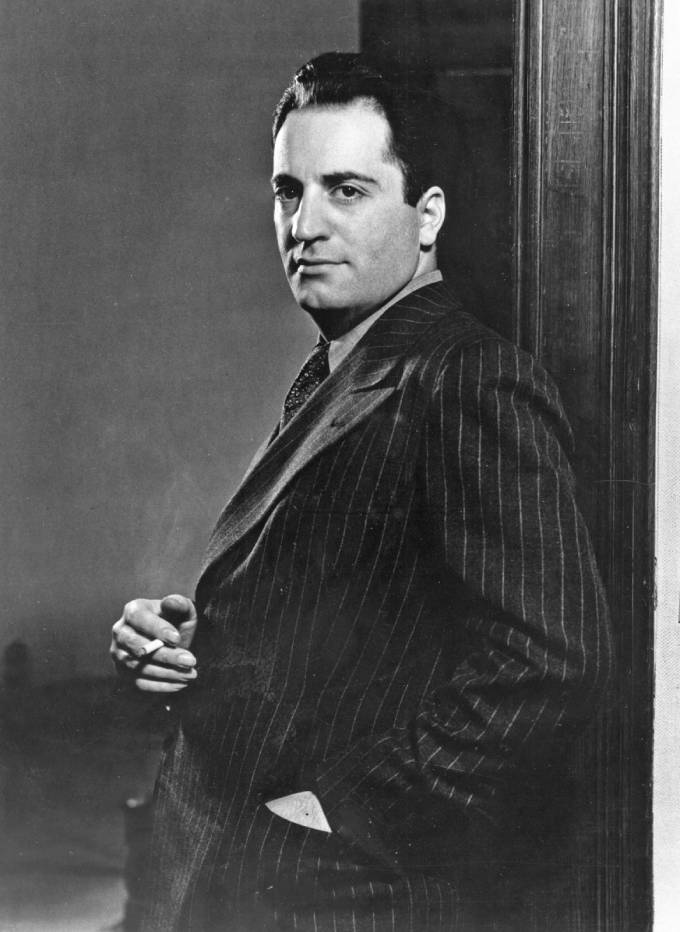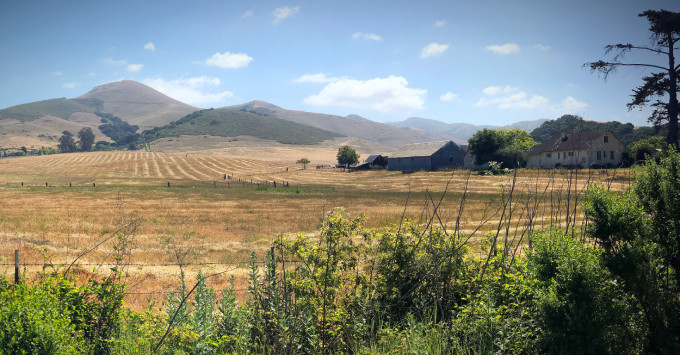It was a time in the mid-1930s. The writer William Saroyan (in undated photo) was driving from San Francisco to Los Angeles and, some miles down the road, decided he’d like to visit John Steinbeck in Pacific Grove. So he detoured. Steinbeck was busy writing but broke off to sit and talk with his fellow Californian.
It was a time in the mid-1930s and the writer William Saroyan decided he’d like to visit John Steinbeck.
Neither could know the coincidence and irony of what was coming. In 1940, both men would win the Pulitzer Prize: Steinbeck in literature for The Grapes of Wrath, Saroyan in drama for The Time of Your Life, an alarmingly original treatment of people waiting for something to happen, and a harbinger of plays like Waiting for Godot—except that in Saroyan’s piece something dramatic finally does happen. Really, what were the odds of a couple of guys sitting in a little room in Pacific Grove, California, each simultaneously nabbing a Pulitzer a few years later—though Saroyan would turn his Pulitzer down, saying he did not believe in awards in the arts. Steinbeck would be quoted as saying, “Bill knows what he wants to do and I don’t see that it is anybody’s business.” He said he felt better about his Pulitzer because Saroyan, though rejecting it, got one too.
Steinbeck said he felt better about his Pulitzer Prize because Saroyan, though rejecting it, got one too.
Of course Steinbeck had already shown what he could do, having written Tortilla Flat, his first popular novel—along with the stories later collected in The Long Valley—and likely at work on his 1937 hit, Of Mice and Men. When they met, however, Saroyan was simply the hottest short story author in America, closely identified with California’s Central Valley and the Armenian community around Fresno, much as Steinbeck came to be with the Salinas Valley and the characters around Monterey County. Known for writing quickly, Saroyan believed in spontaneity—which produced frequent masterpieces but also, now and then, a story that might need more work. But Saroyan was Saroyan, and The Time of Your Life, The Human Comedy, and The Daring Young Man on the Flying Trapeze would make him famous.
Saroyan was simply the hottest short story author in America, closely identified with California’s Central Valley.
Back in Pacific Grove, Steinbeck said he’d like Saroyan to meet Bruce and Jean Ariss, who lived nearby. Bruce was an artist and Jean was a writer whose novel The Shattered Glass was inspired in part by the Monterey of the 1930s and 1940s. Saroyan followed Steinbeck in his car to the young couple’s home, and the evening went well, with plenty of wine and lots of talk. Recalling the evening some years later, Jean said that eventually Steinbeck decided he had to go home and get back to writing. Jean and Bruce invited Saroyan to stay for more talk and another glass, and they mentioned that they had become involved with a local literary magazine. Saroyan found that interesting and asked for more information.
Back in Pacific Grove, Steinbeck said he’d like Saroyan to meet Bruce and Jean Ariss, and the evening went well.
Finally Saroyan said it was time for him to get going. But as he was leaving he changed his mind about trying to drive all the way to Los Angeles. “You know, it’s gotten late and I’m tired and have had too much wine,” he said. “Is there a hotel or inn nearby?” Bruce and Jean recommended one, then said goodbye to the hottest short story writer in America. The next morning they heard a knock on their door. A red-eyed Saroyan stood holding a thin, wrinkled manuscript—“A short story I just wrote. I hope you like it. That will be one dollar, please. And now I have to be on my way.”
The next morning a red-eyed Saroyan stood holding a thin, wrinkled manuscript. ‘That will be one dollar, please.’
“That was so wonderful of him—a William Saroyan short story for our magazine!” Jean told me many years later. “We loved him forever. John Steinbeck was a good friend, but he would never have done something like that for us.” Jean added that, while Steinbeck took time with his writing, spending too long on a short story might have been considered slothful by Saroyan. I don’t know the title of the story Saroyan wrote that night—if Jean told me I’ve forgotten—and I don’t even know if Bruce and Jean ever published it. But the episode meant enough to Jean to have created an indelible memory.
‘We loved him forever. John Steinbeck was a good friend, but he would never have done something like that for us.’
Saroyan first moved me when I did a scene from his sad and lovely play Hello Out There as a student at Los Angeles City College. In it, a young man passing through a small town is falsely accused of rape and jailed. As citizens gather to lynch him, he gives the jail’s shy and gentle young maid the money to get out of town and start a new life, urging her to leave the building before the lynching party arrives. As she exits, their eyes meet and you realize the young man and timid maid have fallen deeply in love. Then there was the inaugural art exhibit at the National Steinbeck Center in Salinas, which I co-curated with Patricia Leach more than 20 years ago. The morning after the opening, a young artist named Gailyn McClanahan walked into our Pacific Grove gallery, looked around, and said, “I have to go get my husband—be right back!” Her husband was William Saroyan’s son Aram, a writer, playwright, and poet. How ironic, I thought at the time: Steinbeck last night, Saroyan today.
Gailyn’s husband was Saroyan’s son Aram. How ironic, I thought at the time: Steinbeck last night, Saroyan today.
Nancy and I got to know and like Gailyn and Aram, and I thought of them when President Biden condemned Turkey for the Armenian genocide during World War I. This horror haunted William Saroyan, who expressed his feelings in the brilliant story-essay “Seventy-Thousand Assyrians.” And I knew that Aram could carry a similar heaviness. At dinner some years ago, the topic of the Armenian genocide came up in conversation and Aram seemed to slip into a dark mood. When he excused himself from the table, Gailyn explained that this happened occasionally, that what had haunted the father also haunted the son.
I thought of them when President Biden condemned Turkey for the Armenian genocide during World War I.
The other day I contacted Aram to ask him what his father would have thought about the President’s comments, and I was saddened to learn that Gailyn, like Nancy, had died. Of his father’s response to Biden’s censorship of Turkey, Aram said, “I certainly support your idea about my father’s no doubt very positive response to President Biden’s official recognition—that Ottoman Turkey’s massacre of the Armenians was an act of genocide.” He continued: “Virtually all Armenians, including hybrids like me, were/are deeply heartened by his act, which has been so long in coming.’’
Aram said, ‘I certainly support your idea about my father’s no doubt very positive response to President Biden’s recognition that Turkey’s massacre of the Armenians was an act of genocide.’
More than a century late! But President Biden deserves great credit for articulating what others thought but shrank from saying. Like William Saroyan, John Steinbeck would approve.



